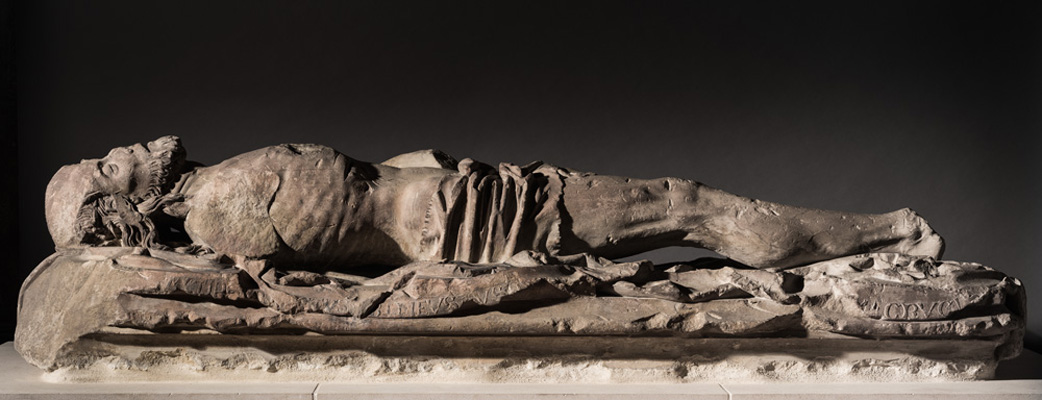
View of the Mercers' Christ from the side showing the text carved around the edges of the cloak

View of the Mercers’ Christ from above showing losses to crown of thorns, hands and feet. Various impact marks can also be seen over the legs and torso

View of the Christ's face showing a thorn piercing his left eyebrow. It is suggested that the sculpture originally had a crown of thorns with delicate filigree carving

Detail of the proper right side of the torso showing the bleeding wound as well as various unidentified marks on the surface, some of which may be graffiti

View of the lower legs showing the remarkable detail in the carving of the veins

Detail from the text around the cloak showing tool marks

Preliminary documentation showing locations of paint samples

A cross section taken from the flesh coloured paint and viewed under high magnification. Pigments detected include lead white, red lead, carbon black, iron oxide and a little yellow ochre

Cross section of paint from the hair showing pigment particles of red earth, carbon black, vermilion and some lead white and chalk

The paint from the mouth was largely made up of rather coarse particles of vermilion

A tiny fragment of gold on one of the letters carved around the cloak shown magnified 60 times, possibly applied over a warm red/orange pigmented layer to enhance its appearance

The Mercers' Christ
This limestone sculpture is owned by the Worshipful Company of Mercers and depicts a life-sized recumbent figure of Christ laid out following his crucifixion. It was discovered beneath the floor of the original Mercers’ chapel in Cheapside during the excavation of this site in 1954 following bomb damage from the Blitz. The artist is unknown, but it is thought that the figure was carved in the late medieval period.
The sculpture may originally have been installed within the hospital church of St Thomas (Becket) of Acon where the Mercers had a chapel from around 1407. It is not known when it was buried and whether or not this was a deliberate act designed to conceal the figure following the Reformation. Although his crown of thorns, hands and feet are missing, this Christ is a unique survival given the destruction of sculpture that took place at the hands of religious reformers in the 16th century. When he was unearthed in 1954 traces of original colour were still visible on the surface. The flesh was pink, the hair a reddish brown and the tongue red with white teeth. The surface now appears unpainted, perhaps as a result of cleaning following its discovery. However, scientific examination of the sculpture in the 1970s confirmed the eyewitness accounts and a number of pigments were detected in surviving paint fragments on the body.
The archivist of Mercers' Hall contacted us to request a new technical and visual examination of the sculpture in the hope that this might capture some additional information. The technical study was undertaken between Patina and the paintings conservator Abigail Granville, who undertook the scientific analysis in collaboration with a number of colleagues. Overall photography from all angles was carried out by the photographer Mark Heathcote, who then took a number of high resolution details of the surface that gave us valuable information about the fabrication of the sculpture showing, hitherto unseen details of carving tools and technique.
This was followed by a more detailed visual examination of the sculpture under high magnification to document the surface for traces of pigment or gilding. Minute samples were taken from some of the remaining fragments of paint and were cross sectioned to try to identify pigments and media present. Energy Dispersive X-Ray analysis (EDX) was then used to target individual layers in the paint cross sections and give elemental information on the distribution of inorganic pigments. Pigment analysis confirmed the presence of a lead white priming layer applied to the whole of the carved surface. A pink flesh colour, containing lead white, red lead, carbon black, yellow ochre, was then applied over much of the body apart from the white loincloth. Analysis of the hair showed a brown colour made up of red earth, vermilion, chalk, carbon black and red lead and the mouth was painted using a bright red vermilion. Charcoal black, chalk and red earth, suggesting a dark brown or purple colour, were found on the cloak. Finally, microscopic examination in combination with XRF analysis confirmed the presence of gilding on the writing carved around the cloak - an exciting discovery that shows how the text must have been intended to stand out against the dark coloured cloak in the candlelit environment of the original chapel.
This investigation added detail to previous research and has helped The Mercers' Company to build a clearer picture of the techniques used in the fabrication of this remarkable sculpture.
With thanks to:
Jane Ruddell, archivist at Mercers' Hall, for all her help and encouragement during this project
Abigail Granville, painting conservator, for her work on the analysis
Mark Heathcote, photographer, for his work with the photography
Abigail’s analysis was carried out with the assistance of:
Helen Howard (National Gallery)
David Peggie (National Gallery)
Art Access & Research
Vanessa Simeoni (Westminster Abbey)
Name | The Mercers' Christ |
|---|---|
Location | Mercers' Hall, London |